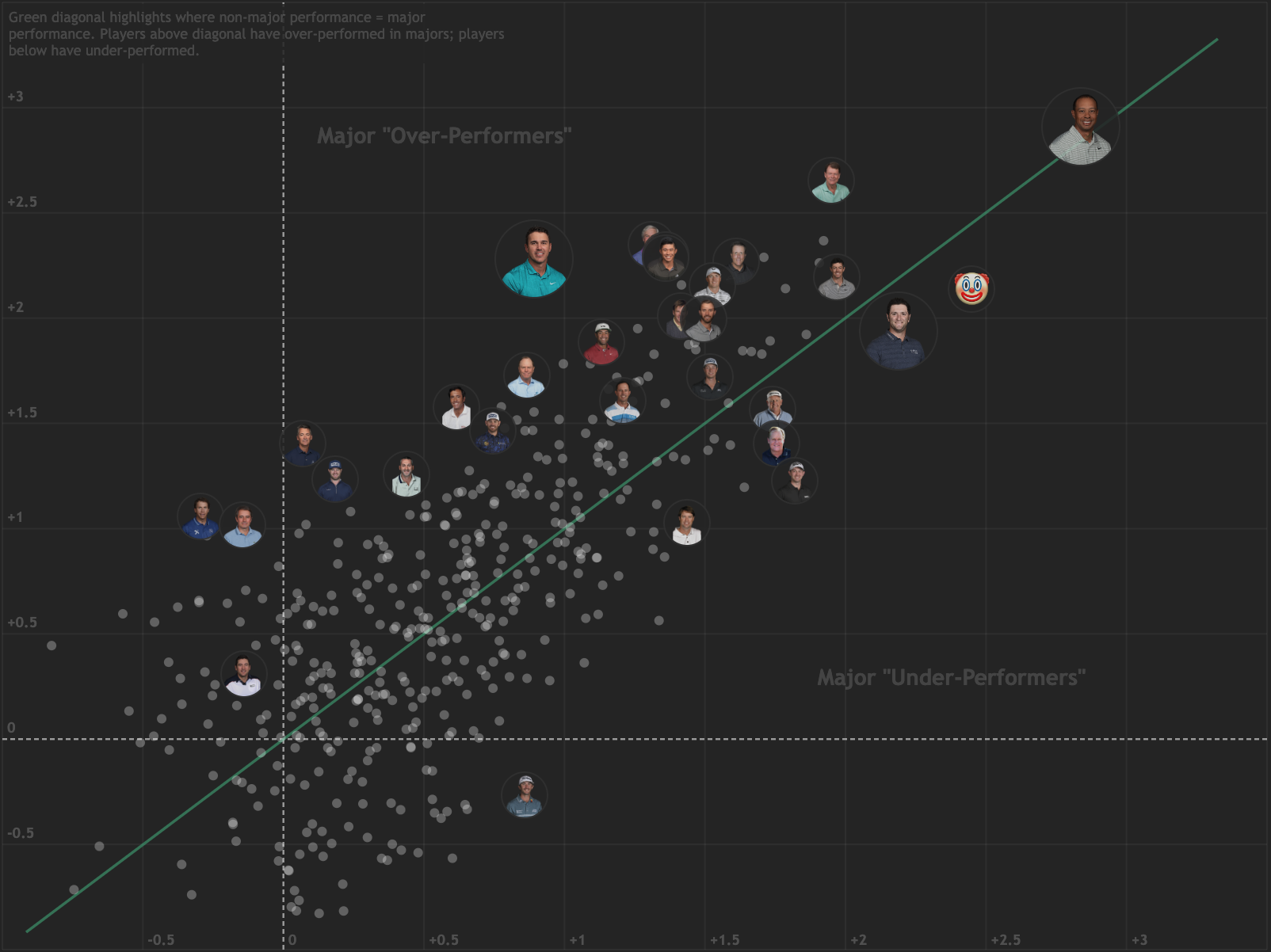
 I.T.N. No. 18
I.T.N. No. 18PUBLISHED March 23, 2020
Inside The Numbers ...
is a brief numerical summary of the current happenings in the world golf, published every Monday — hopefully.
30.5% WIN PROBABILITY
The 2019 Masters will be remembered for many reasons, one of which will likely not be
that Xander Schauffele was the odds-on favourite to win well into the back nine on Sunday.
Through 14 holes of his final round, Schauffele was tied with Patrick Cantlay (who was through 15 holes)
at 12 under par; Molinari, Woods, and Koepka were all 1 stroke back at -11. According to our live model,
the win probability shares looked like this at that moment:
Ultimately Xander couldn’t
close the deal, in large part due to a costly par at 15. For those of you getting hit by a wave of nostalgia,
we’ve made an
animated — and annotated — webpage, allowing
you to revisit the
leaderboard and our win probabilities at each point in time on that crazy Sunday.
+1.75 STROKES-GAINED APPROACH PER ROUND
Using sophisticated statistical methods, we’ve managed to uncover a rather startling fact:
Tiger Woods, at one point in his career,
was pretty good with an iron in his hand.
Yes I know — but bear with me here. More specifically, on March 23, 2008, we
estimated that Tiger’s skill level on approach shots — that is, the number of strokes
we would expect him to gain on approach shots in his next round — was +1.75 strokes per round.
How good is that? For context, recall that at any point in time, a top 5 golfer in the world would
be expected to gain about 2 strokes per round over an average PGA Tour professional;
Tiger was coming close to accomplishing this on approach shots alone.
For further context: the second best SG: Approach skill level we have in our data,
from a player not named Tiger, was +1.25 for Sergio Garcia in February 2005.
0.3 STROKES BETTER THAN 'PEAK' TIGER WOODS
What is the upper bound of performance in golf? At his best, we estimated that Tiger's overall skill level was 3.6 strokes
better per round than an average PGA Tour professional; this peak was reached in February 2008. (We also put Woods' skill
at a similar level at various points in the '00 and '01 seasons.) Again, remember that skill is defined as our expectation
for Tiger's performance in his next round; therefore, despite the fact that Tiger has had fairly long stretches of play
averaging
above 4 strokes-gained per round, he never reached the point where we expected this performance from him. But, is this really an upper bound?
For a different answer, let's aggregate the highest all-time skill levels we have for each strokes-gained category. Excluding Tiger,
these are:
Off-the-tee: +1.37 — Bubba Watson, Feb 2013
Approach: +1.25 — Sergio Garcia, Feb 2005
Around-the-green: +0.51 — Kevin Na, Sept 2015
Putting: +0.76 — Luke Donald, April 2012
(A very interesting aside here that deserves mention is that for both putting and around-the-green performance, the highest skill level ever reached is still less than
what the best mark is for each category in a typical season — speaking to the substantial role luck plays in both of these shot categories.)
These add up to a grand total of 3.9 strokes better than an average PGA Tour professional — just 0.3 strokes better than peak Tiger Woods. If we allow Tiger into the mix of golfers to choose from, our total moves from 3.9 to 4.4 strokes-gained. (Tiger has the highest-recorded approach skill at +1.75, and also tied Donald's putting mark in Jan 2005.) So, what's our takeaway here? Attitudes towards Tiger's greatness should be tempered: even at his best, Tiger was leaving 0.8 strokes per round out there.
Off-the-tee: +1.37 — Bubba Watson, Feb 2013
Approach: +1.25 — Sergio Garcia, Feb 2005
Around-the-green: +0.51 — Kevin Na, Sept 2015
Putting: +0.76 — Luke Donald, April 2012
These add up to a grand total of 3.9 strokes better than an average PGA Tour professional — just 0.3 strokes better than peak Tiger Woods. If we allow Tiger into the mix of golfers to choose from, our total moves from 3.9 to 4.4 strokes-gained. (Tiger has the highest-recorded approach skill at +1.75, and also tied Donald's putting mark in Jan 2005.) So, what's our takeaway here? Attitudes towards Tiger's greatness should be tempered: even at his best, Tiger was leaving 0.8 strokes per round out there.
Addendum:
It's been pointed out to us that this exercise does not quite make sense! It is incorrect to assume that the strokes-gained skill numbers can just be combined additively; if a player is gaining a lot of strokes off the tee and on approach, it will be difficult for them to gain (or lose) strokes around the greens, simply because they won't have many around-the-green shots to hit. This logic could hold for all the categories, but it is probably just the around-the-green category that would be substantially affected. This is similar to something economists call general equilibrium effects; often it is incorrect to 'hold things constant' when thinking through the implications of some policy (the policy here is increasing a golfer's SG:OTT and SG:APP; the implications are what happens to total strokes-gained). The upshot is that we have overestimated the total strokes-gained the best combination of golfers could achieve. For reference, at his peak Tiger's category breakdown was: +0.9 OTT, +1.75 APP, +0.25 ARG, +0.7 PUTT. My guess is still that the combination of golfers would beat that slightly, but a more involved analysis would be required to determine that.
It's been pointed out to us that this exercise does not quite make sense! It is incorrect to assume that the strokes-gained skill numbers can just be combined additively; if a player is gaining a lot of strokes off the tee and on approach, it will be difficult for them to gain (or lose) strokes around the greens, simply because they won't have many around-the-green shots to hit. This logic could hold for all the categories, but it is probably just the around-the-green category that would be substantially affected. This is similar to something economists call general equilibrium effects; often it is incorrect to 'hold things constant' when thinking through the implications of some policy (the policy here is increasing a golfer's SG:OTT and SG:APP; the implications are what happens to total strokes-gained). The upshot is that we have overestimated the total strokes-gained the best combination of golfers could achieve. For reference, at his peak Tiger's category breakdown was: +0.9 OTT, +1.75 APP, +0.25 ARG, +0.7 PUTT. My guess is still that the combination of golfers would beat that slightly, but a more involved analysis would be required to determine that.
33 YARDS
Who is the longest player on the PGA Tour? Restricting our attention to the last 15 years, there are really only
a few candidates to consider: Bubba Watson, Rory McIlroy, Dustin Johnson, and J.B. Holmes. Below I've plotted
our predicted driving distance for each golfer over time. As with
true strokes-gained, these predictions are based off driving
distance numbers that have been adjusted for course-specific conditions and are interpreted relative
to an average PGA Tour professional.
The mid 2000s versions of Bubba Watson and J.B. Holmes were separating themselves from the field off-the-tee
by around 30 yards, a feat we haven't really seen consistently since then. The narrowing of the gap between Watson and Holmes
and the field average likely speaks more to how the field average has changed over time than changes
to Watson and Holmes' games. To answer the question posed in the outset, I would give the slight nod to Dustin
Johnson.
In 2018 however, a new contender emerged for the title of longest-on-tour: Cameron Champ. Champ has the longest predicted driving distance in our data at any point in time, at +33 yards relative to the tour average, recorded in November 2018. As you can see in the plot, despite our predicted driving distances bouncing around a fair bit, Champ has had the highest predicted distance at every point in time since he joined the PGA Tour; impressive stuff.
In 2018 however, a new contender emerged for the title of longest-on-tour: Cameron Champ. Champ has the longest predicted driving distance in our data at any point in time, at +33 yards relative to the tour average, recorded in November 2018. As you can see in the plot, despite our predicted driving distances bouncing around a fair bit, Champ has had the highest predicted distance at every point in time since he joined the PGA Tour; impressive stuff.
43 RANKING POSITIONS
While the Players Championship was cancelled after just a single round (er.. after 99% of a round),
that round still provides as much information as any other with regards to golfer performance.
The biggest mover in
our rankings was Si Woo Kim, jumping 43 spots from 287 to 244.
Si Woo fired a
7-under-par 65, equivalent to +6.9 true strokes-gained — a nice change of pace from some
of the catastrophic
performances he put up earlier this year. Matsuyama's pace-setting 63 was the 4th best
round of his career (according to the true strokes-gained metric), allowing him to leapfrog Webb Simpson
in our rankings and move into the 4th spot.
I.T.N. ARCHIVE
RECOMMENDED BLOGS
Recent Blog Posts
Model Talk Blog
Does our model overvalue leaders?

 Data Visualization Blog
Data Visualization Blog
Skill Distribution of Major Champions









